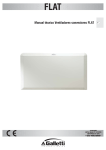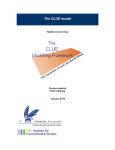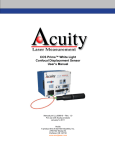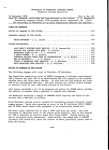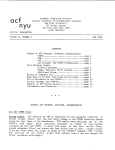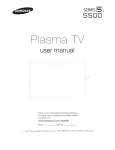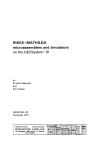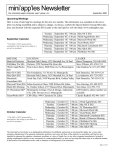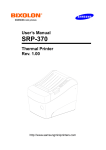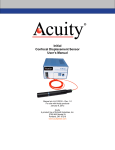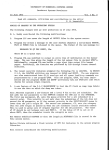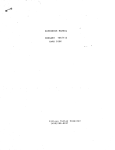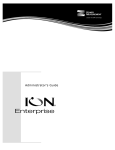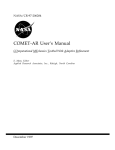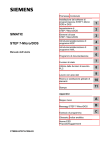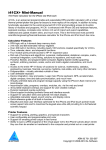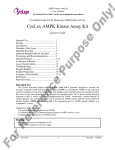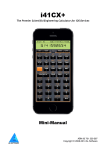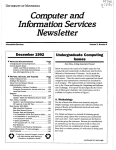Download v01n04 (7.596Mb application/pdf)
Transcript
UNIVERSITY OF MINNESOTA COMPUTER CENTER
Deadstart Systems Newsletter
18 June 1975
Vol. 1 No. 4
Send all comments, criticisms and contributions to the editor
T. t?. Lanzatella
NOTICE OF CHANGES TO THE OPERATING SYSTEM
The following changes were brought into production on 1 May 1975.
Bruce Johnson installed a new message in DSD, VP BUSY, which appears in the I
display whenever a transfer is in progress between the CYBER and the PDP-11.
Bruce also changed DMQ and LDQ so that QT = PL is recognized on the command,thus
allowing dumping and loading of PLOT type files.
Kevin Matthews modified lAJ so that MS PRU's transferred by LDR during program
loading are logged in MSUW in the control point area.
Tom Lanzatella implemented modification LINK28A from PSR 393. The mod fixes a
bug in CDC's implementation of extended replication table processing in LINK.
Without the correction, several RUN23 programs do not load correctly.
N.L. Reddy added more code to BATCHIO, this time to 110 which further enhances the
plotter interface. The program 110 now treats PQ as a controller and searches the
queue for PLOT type files. PQ is really a PDP-11.
Stuart Lenz implemented the following changes to NF501:
1.
A test and message for empty input file with a new parameter on the control
card, E, which directs MF501 to abort on empty input file.
2.
A new parameter on the control card which directs MF501 to perform an internal
tape request.
3.
Repair various sundry documentation errors.
Bill Elliott added the following modifications:
1.
A C option to TDUMP which allows dumping of even parity S, SI, L and F made
tapes.
2.
A new DSD display E,U which displays MAGNETS's UDT's.
3.
An assembly constant was added to COMP3XD to accomodate a new version of CERTIFY.
The constant changes treatment of the tape controller by COMP3XD.
James Mundstock added code to !SF so thatthe CALLPRG index is treated as a fast
attach permanent file. Jim also made the following changes to CALLPRG:
1.
The index file, SCRl, is now returned in all instances.
2.
The L
3.
WRITEUP no longer writes EOF's on file OUTPUT.
= lfn option now works on WRITEUP.
4.
CALLPRG now copies tapes to the auxiliary device SP.
Alan Johnston contributed the following changes:
1.
A new version of the PP common deck COMPUPS which unpacks a control card
to a character buffer. The current CDC version of the common deck has many
errors and is not reentrant. The new version of COMPUPS will be sent to
CDC as suggested corrective code against the current version.
2.
A modification from PSR 404 (level 9) which fixes the use of the A}I parameter (maximum field length) in the IPRDECK when it was not set to 7777.
3.
A generalization of one character file types for DSD commands. This modification introduces a micro #QFNM~ and a macro QINDER. The micro contains
one character for each queue type. The macro generates table entries for
DSD with the appropriate symbols and values for the tables. In the future,
additon or deletion of queue types will require only a change to the micro.
This modification enables the operators to get the plotter, hatcher and
XMIT queues.
4.
Word 43B in the installation area of the control point area in PPTEXT is
now tagged SOBW. The word will be used by future U of M modifications.
5.
Bit 58 of SOBW is now used to indicate that all files with 74B ID attached
to the job should be returned at the next job step. All SSJ = jobs with a
parameter block set all created files with 74B ID and set bit 58 of SOBW.
SSJ = jobs without a parameter block do not have this feature but LFM now
sets bit 58 of SOBW whenever a SETID with 74B ID is processed. Additionally,
the attach control statement function in LFM now sets this bit in SOB\-1.
This used to be a way of getting passwords since whenever CONTROL aborte:i
it left the control statement file entry in the FNT in tact with tracks
released thus leaving the disk open to random examination.
'"'6.
The clear core function before program load, CPM function 72, now uses bit
59 of SOBW instead of LDCW, the loader control word. This change is for U
of M generalization and apparent changes CDC may make in LDCW. Also, this
function was moved to CPU MONITOR instead of placing it in the PP program
CPM.
Marisa R~vie~~changed MODIFY, VFYLIB, VERIFY and LIBEDIT so that a Q is not output
as first character of the OUTPUT file if the file is of time sharing type. Marisa
also changed MODIFY to suppress page skipping when only one line was written on
the previous page.
'The following changes will go into production on Tuesday, 1 July 1975.
James Mundstock contributed the following modifications:
1.
2.
3.
A modification to CPM which prevents user initiated rollouts of less than
eight seconds. All user initiated rollouts of less than eight seconds are set
to eight seconds.
A fix to lAJ which repairs time limit error processing. lAJ was reprieving
time limit errors by adding eight times the validated time limit to the job.
A modification to CALLPRG so that if the fast attach copy of the CALLPRG
INDEX is not available the indirect access copy is used.
-2-
4.
A modification to CALLPRG which prevents the program from loading tape files
to the device SP but attempting to purge the files from the default system
device.
5.
Program WRITEUP now outputs a message when a user requests a non-existent
writeup.
T. W. Lanzatella added the following modifications:
1.
Program lAJ no longer allows internal user requests to load programs with
an SSJ = entry point.
2.
Program MODVAL no longer allows a user to execute a PASSWOR control card unless
the user number which password is to be changed has password change peruission.
This change is necessary because certain malicious users were changing passwords of class user numbers.
N. L. Reddy has fixed the DISPOSE entry in FILES to be reentrant. Program FILES,
like PFILES, has a look ahead feature. Previously, two sequential DISPOSE commands
did not work correctly.
Bill Elliott modified the DENSITY control card to accept mnemonics HY, LO, etc.
rather than numeric values for density. Bill also changed PFILES as follows:
1.
The ACQUIREandRETAIN·contralcards are now installed.
for FSAVE.
RETAIN is the new nane
2.
The PG parameter is now recognized on the DEFINE command. This parameter
replaces the old FDEFINE command. PG means that the file will be purged
before being defined.
Marisa Riviere has altered DOCUHENT to accept the symbols .PDPll and .END as
keywords indicating the start and end, respectively, of PDP-11 documentation.
Marisa also changed the origin of program MODIFY to allow use of the Z parameter
when MODIFY is called from a local file.
PROPOSED CHANGES TO THE OPERATING SYSTEM
Marisa Riviere proposes a modification to PFILES which would allow the user
control word (UCW) field of a permanent file to be set by the control cards
SAVE, DEFINE, RETAIN and CHANGE. Currently, this is possible only through
internal calls to PFM. The utility of such a change would lie in the ability
of a local version of CATLIST (for example) to group files according to the
UCW field. The program RFM currently uses the UCW field for just such a purpose.
Alan Johnston contributed the following objections to the proposed change in the
micro NMOT.
As stated in the Deadstart Newsletter and Yuccs, there is a proposal to change
the batch two character name in the NMOT micro from 'BC' to 'LD'. We believe
that such a change should not be instigated for the following reasons:
1.
Many users, including ourselves, are accustomed to the use of 'BC' as
a site code for the parameters on control cards. Changing the site to
-3-
'LD' invokes confusion to users and to the parameters on control cards .
2.
The KRONOS reference manual states that the central batch site is 'BC'
(pages 5-16~ 5-32, 7-29). Conflicts will occur with users who read
the reference manual and what actually is.
3.
Changing the batch site 'LD', which I assume means Lauderdale~ is
ambigious. There exists two I/O stations at Lauderdale, the Univac
1004 and the CDC on site equipment. Some users may become confused
as to which place 'LD' refers to, and not know where to pick up their
output.
4.
The micro NMOT is used to generate a two character name which designates
the origin of the job. The site codes are determined with the first
character being the origin and the second the terminal identifier. But
the central site 'BC' is always the same~ since there is only one
central I/O station at the present. The current symbol 'BC' is
sufficient and is generalized for future central batch sites •
.In the previous issue of the DEADSTART SYSTEMS NEWSLETTER, attention was brought
:to a small dispute between KCM and NLR over whether or not maintenance routines
should be internally initiated and scheduled by KRONOS. Several discussions
ensued and a formidable list of advantages of internal maintenance job scheduling
was the result. The list~ due to N.L. Reddy, is presented here.
ADVANTAGES OF SCHEDULER RUNNING MAINTENANCE JOBS
1.
This is a natural extension of the functions of the scheduler.
"bending" of the operating system is involved.
No
c2.
The routines will be scheduled evenly, like one every 5 minutes, instead of
running them all at once every 17 minutes. Errors will be caught sooner.
3.
Far, far less overhead to the system. No rolling priority evalution, calling
other PP's is involved. No disk activity is involved in bringing a routine
to a control point, other than loading the routine. Procedure calls are
very expensive.
4.
Some of the routines need a different seed every ~un, so that they may test
a different section of the main frame in a more random fashion. Only the
s~heduler can maintain and generate a new seed for every call.
5.
In th~ procedure-oriented scheme, thP routines are initiated by ISF (Initiate
System Files). ISF clears out all resource files like ResexDF, ResexVF, etc.
which hold information about current resource allocation. So ISF can be
run only when there is no job in the system requesting or holding a resource.
So if for some reason, the routines have to be restarted, it can be done only
~nder "DIS" from the console.
In the scheduler controlled scheme, the jobs will be run as long as the
scheduler is active, in other words, as long as the system is up.
·6.
If the procedure file is lost in a disk crash, no maintenance job will be
initiated.
-4-
7.
If a routine does find a hardware problem, it can be allowed to end normally
giving all the information in its output file.
No restarting will be necessary.
8.
In the procedure-call, the job has a funny name like 555AAE2, which does not
mean much to operators, accounting or anybody else. This is true whether it
is running at a CP or is in the rollout queue.
9.
Maintenance routines are truly system-origin jobs, and in the scheduler controlled scheme they will be system jobs with meaningful job names. In procedure call, they are submitted jobs with a BATCH origin.
10.
Operator will be able to control the running with DISABLE, MAINTENANCE and
ENABLE, MAINTENANCE. The interval for calling the routines can also be set
from the console. This is possible only with the scheduler.
11.
If CDC ever implements the scheme under NOS, it is more likely to be in the
scheduler than anywhere else. In fact, scheduler is the most natural place
to put this stuff in.
12.
If the rolled-out job under the Procedure Scheme disappears or gets dropped
by the operator etc., re-starting is not easy. But the scheduler is not
subject to these.
13.
Adding a new routine to the list means a sysedit under the scheduler scheme.
One has to go under "DIS" to replace a permanent file and submit it under
the procedure scheme. During production, doing a sysedit from __a _card _deck
is simpler and less of an inconvenience to Operations then use of the console.
Anyway I don't anticipate adding routines in a hurry.
14.
Effort involved is not much, as all the work to the scheduler has been done,
only DSD commands have to be added along with suitable changes to PPTEXT.
15.
When we add the ECS test routine EC3 to the system, there has to be a request
for ECS FL. If some user has got it tied up for a couple of hours, no
maintenance routine would run during that period under the procedure-sche~e.
But under the scheduler-scheme EC3 would not be scheduled at all, if that
resource was not available, and other routines would be scheduled as usual.
When ECS became available, 'it would be scheduled in the proper order. This
can be extended to other resources, if necessary in the future.
16.
Procedure files are one of the most convenient tools in KRONOS, but they can
never compete with a system routine, in stability, efficiency, inexpensiveness of system utilization, etc.
SYSTEM MAINTENANCE:
PROCEDURES A...'W PEOPLE
A correction to the 16 April 1975 DEADSTART SYSTEMS NEWSLETTER: Please send a
rough draft of all CDC PSR's to Betty Stahl. She will have it typed in final
form, submit it and maintain a record of date published and reply.
-5-
The
The
one
not
following is a control card responsiblity list compiled by Andy Mickel.
list is intended to indicate roughly what people are working with. Often
program (especially a popular systems routine) is affected by many people just the persons indicated.
CONTROL CARD RESPONSIBILITY LIST - ABM 6/25/75
[-C
J. Cosgrove:
~
-C
W. Elliott:
= operating
system]
M. Frisch:
FORPREP (with K. Frankowski), TXTEDT (with M. Riviere), ARTHUR
(with C. Liedke), PERT66
D. Hamnes:
BASIC, DISPOSE, MIMIC, SIMS, SIMULA
B. Johnson:
~
A. Johnston:
-C
~
BLANK, DENSITY, LABEL LISTLB, NEXTVSN, PACK, PREVIEW, RESOURC,
UNLOAD, VSN, EXAMINE, RETAIN, ACQUIRE
.~
~
compilers
BUILD, S2000, PLIFOR, PLICOB
R. Hotchkiss:
-C
=
H. Kurs:
EMULATE, SAP, UMRPG
DMPCOR, DMPECS
CLEAR
COBOL, FILE, SORTMRG, SORTMR3, CREATE, IXGEN, SISTAT, ESTIMATE
T. Lanzatella:
S. Lenz:
MFSOl, MIXAL, UTALGOL, MIXBYTE
D. Lienke:
S. Lin:
CKP, DOCUMENT, RESTART, SETDFL, SYSEDIT, PLONE (see also G.S.)
EDIT, STRATEN, UPDATE
APEX, DRESS, GPSS, LPKODE
OMNITAB
0
K. Matthews:
CALL, CATLIST, CHANGE, DEFINE, DAYFILE, DUMPPF, ECS, LOADPF,
LOADSD, SAVE (see also G.S.), OPLEDIT, KRONREF, UPMOD
~
R. Matthews:
LINK, LOAD, MODIFY, MAP
•C
A.Mickel:
-C
E. Mundstock:
R. Myster:
LISP, PASCAL, PSCXREF, SNOBOL, SNOBOLC, SPRUCE, TYPESET
BATCHER, FETCH, FUTURE, MNF, PAST, WRITEUP, BASIC, FTN, RUN (with CDC)
UMTIMER
S. Nachtsheim:
0
N. Reddy:
~
M. Riviere:
BUILD, COPYCL, KWIC, PLICOB, PLIFOR, S2000, S2000RW, TRIAL
ACCOUNT, BIN, COMPASS, DISPOSE, LIMITS, OUT, RENk~, ROLLOUT, SEND,
SUBMIT, CHARGE, FAMILY, MODVAL, PROFILE, SETID, MODUP
ALGOL, LIBEDIT, TXTEDT
-6-
-c
~
W. Sackett:
T. Salo:
APL
AMEND, COST, PACKMS, REBLOCK
-C
B. Stahl:
MNF, TIDY
-C
J.Strait:
PASCAL, CNOBOLC, UNPAGE
B. Williams:
S. Yen:
~
XEDIT
BCTRY, all BMDnmX, CTAB, ISIS (with L. May), SPSS, all UMSTnmO
GENERAL SYSTEHS (G.S.)
jobcard, APPEND, ATTACH, BKSP, CATALOG, CO}lliENT, COPY, COPYBF, COPYBR, COPYCF,
COPYCR, COPYEI, COPYSBF, COPUU, COPYX, CTIME, DISPLAY, D}ID, DMP, EVICT,
EXECUTE, EXIT, GET, GOTO, GTR, IF, LBC, LDI, LDSET, LIBGEN, LIBRARY, LIST80,
LOC, LOCK, L072, MODE, NOEXIT, NOGO, N O~L\P, OFFSW, ONEXIT, O ~~S\-7, OUT, PACK,
PACKNAM, PASSWOR, PBC, PERMIT, PURGALL, PURGE, RBR, REDUCE, REPLACE, RESEQ,
RETURN, REWIND, RFL, RTIME, SET, SETCORE, SETPR, SETTL, SKIPEI, SKIPF,
SKIPFB, SKIPR, SORT, SWITCH, TDUMP, UNLOCK, VERIFY, VFYLIB, WBR, WRITEF,
WRITER, ASSIGN, COMMON, RELEASE, REQUEST, STAGE, SUI, USECPU.
This memo about CALLPRG discusses five unrelated topics. Part I and the references
to CALLPRG in the DEADSTART SYSTEMS NEWSLETTER of April 17, 1975 should be read
first to understand the following parts.
1.
NEW CALLPRG PROCEDURES
Please read the description about the CALLPRG procedures on the DEADSTART
SYSTEMS NEWSLETTER of April 17.
I plan to implement the procedures that are described there by the middle of
July. This will give you enough time to become familiar with the new procedures. If you have any questions or if you would like to have a meeting
to discuss the new procedures, please tell me to arrange it.
2.
PACKNAME FOR THE CALLPRG · FILES
Most of the UCC CALLPRG packages have been moved to the SP pack to improve
distribution of disk space.
The CALLPRG index (CALLPRG), the new version of the index (NEHCP) and the
OPL that shows all the NEWCP modifications (CPOPL) remain on the STF pack.
3.
CALLPRG INDEX MODIFICATIONS
I modify the CALLPRG index once a week. Every request submitted before Thursday noon will go on the system the following weekend.
To avoid introducing errors on the CALLPRG index cards you should test the
new cards before sending them to me. The new index cards can be tested in a
local CALLPRG index. The following example illustrates a new index card
-7-
test job.
CBF {INPUT, CALLPRG}
FETCH,OPL.
7/8/9
.LOCAL CALLPRG INDEX TEST FILE
OPL,TY = FETCH, UN = YZE6008, PN = SP, lA = OPL.
Note that for the test job, the CALLPRG index is your own local file and
the job does not need to be run under the CALLPRG account number. Also
note that at the time you test the new card, the file must be already
saved, defined or written on tape, as it will be once the card is included
on the UCC CALLPRG index.
4.
THE CALLPRG INDEX AS A SOURCE OF USER'S
INFOR}~TIO~
- PASSWORDS ON CALLPRG FILES
The CALLPRG index is a public file and therefore any user that knows the CALLPRG
account number can list it.
There is no harm in users obtaining lists of the CALLPRG index. However,
the CALLPRG index is not an official source of information about what is
available on the UCC KRONOS System. (CALLPRG may include some special private
user's packages and some UCC staff packages still in debugging stage.)
The use of passwords on the CALLPRG files is meaningless, since the passwords
are included on the list of the index.
5.
PRIVATE PACKAGES AND CALLPRG
The CALLPRG index should include mainly UCC staff packages. CALLPRG can
handle local CALLPRG indices that may be supplied by private users to access
their own packages. The card a user must add to access a private CALLPRG
index is:
GET, CALLPRG/UN = nnnnnnn.
This card has to precede the cards that reference the private packages.
CALLPRG searches the local CALLPRG index to find a requested package. If
the package is not included on the local index, CALLPRG proceeds to search
the UCC CALLPRG index. If the user wants to suppress the searching of the
UCC CALLPRG index, the local index has to include the parameter SW = • on
the DEFAULT card.
In the case that later in the job the user needs to reference a UCC CALLPRG
package which name is also included in the local CALLPRG index, he should
insert a second card returning the local CALLPRG file. This will allow
the CALLPRG program to scan the UCC CALLPRG index for the UCC version of
that package.
~xceptions to include private packages in the UCC index can be made, if the
need is really justified. (e.g., private packages used by very large groups
of computer class students at an elementary level when the use of extra
control cards may become confusing.) In these cases, please contact me for
the arrangements.
M. Riviere
April, 1975
-8-
LETTERS TO THE EDITOR
To the Editor, Deadstart Systems Newsletter:
The purpose of this letter is to comment upon recent discussions concerning
"policies" in the Systems Group. Originally I wanted to comment on certain
specific proposed changes to the operating system (FSAVE and FDEFINE) but these
issues have now been resolved, and I will instead address general concerns.
Hopefully this letter will serve at least to get some things written down in
the DEADSTART SYSTEMS NEWSLETTER, but more importantly to elicit comment from
other members of the Systems Group (the Kronos Kronie Klan).
There are four sections following:
and documentation.
example problems, stated policies, change,
Example Problems
1.
The DEADSTART SYSTEMS NEWSLETTER has become a valuable source of information
concerning changes to the operating system. But the DEADSTART SYSTEMS NEWSLETTER has only existed since February, 1975. I would like to see printed in
a future issue, a list ( or at least a summary) of all changes to KRONOS
before February, 1975. Examples include the infamous change of the TXOT
symbol in PPTEXT. (And I just found out last week that PPTEXT itself is
local to the U of M!)
2.
SUBMIT as is currently implemented is not standard and the documentation of
changes are not easily available. Just one control card of many, I suspect.
3.
Our documentation efforts seem to be on track according to our original plans
when we went to KRONOS. But it is very apparent that we need to review our
scheme! (see sction on documentation)
These problems and others need to be attacked.
Stated Policies
Concerning the most recently stated policies from Systems Group meetings:
1.
All proposed changes must be brought before a Systems Group meeting for
open discussion and the proposed change should be explained fully and
candidly in the DEADSTART SYSTEMS NEWSLETTER prior to the meeting.
2.
There exist rules of etiquette for using the console on systems time.
3.
Staff persons should keep all but a few procedure files on the Staff pack
(PN = STF) and keep the total number of sectors used below 1 or 2 thousand
sectors. PN = SP should not be used by staff for private files, and PN =
SYSTEM (the removable pack) should be used for very long direct access files
(such as OPL's).
Other policies are:
1.
The current documentation scheme calls for trying to stay with standard KRONOS
but information for any changes should be placed under \f.RITED~, in SYSNOTES,
and in the UCC NEWSLETTER. DOCMENTed files of standard routines should have =
-9-
signs in the left margin by the stated differences.
2.
Changes for language processors are phased in by the FUTURE, current, and
PAST hierarchy and no change takes place during a school quarter.
3.
All CDC PSR's must be routed through Betty Stahl for coordination and followup.
4.
And to resurrect an old opinion (which might become a policy), see the
attached memo from Roger Gulbranson to Larry Liddiard from June of last year
concerning System Initialization after Normal Deadstart.
Change
When we decided to go to KRONOS in November of 1973, we took a not-so-solemn vow
to avoid another MOMS (the Mine, Ours, MACE, and SCOPE local system). MOMS was
-poorly documented and unwieldly. Now in May, 1975 after having made some substantial changes to KRONOS we should be consciously aware of preventing the
evolution of a POPS (Polluted Operating System) of a similar nature - son of MOMS
grown up.
Of course, certain changes are highly desirable in all respects as we customize
KRONOS to fit the needs of our installation. But changes must be made with the
knowledge of all the consequences, including:
1.
Making the change in a way that fits into the unifying underlaying concepts of
KRONOS (uniformity, internal documentation standards, easy to use, consistent
in syntax,etc.)
2.
Informing users of the change initially.
3.
Documenting the change adequately and permanently.
4.
Implementing the change via programming.
It may well be the case that a change which seems to be a natural thing to do on
the basis of programming or execution efficiency may be outweighed by the factors
of cost and bother of fully carrying out the change all the way through user services
so that it will be used effectively by programmers. Since according to Steve
Nachtsheim, the Information System Group has estimated that each new control card
costs UCC about $2000 all told, we should carefully consider our actions before
"'"plunging in.
Half of the Systems Group is at Experimental Engineering and their experience with
users is certainly different from that of the half at Lauderdale. We don't want
to give users the view that 1) we have priorities for change not matching theirs
and 2) we have time on our hands for implementing frivolous features.
On the subject of esthetics in change and systematic overall design of the
operating system, Ben Sheiderman of the University of Indiana (who was here at
Minnesota to speak in March) in a recent technical report entitled "Experimental
Testing in Programming Languages, Stylistic Considerations and Design Techniques"
states: "As the issues become more subtle, it is no longer acceptable for
developers and implementors to make highly subjective and personalized statements
concerning the worthiness of a particular languagefeature or stylistic technique.
The rampant proliferation of new dialects or entirely new languages is counterproductive since it limits the sharing of programs. A concerted effort must be
made to ensure that new features, dialects, languages, and techniques are truly
improvements. Control cards for operating systems and utility programs could also
be improved by proper experiments with users. As computer utilization
-10-
becomes more widespread, large numbers of programming amateurs in diverse
disciplines will demand facilities which are simple to use."
Documentation
How do we introduce change and how do we expect users to find out information
about these changes? What is your definiton of the term "users"? From my
consulting experience, at least half of the users oriented to batch processing
do not know what a control card is. The situation seems to be much better
with timesharing users. We need to aim for a single source of information, kept
up-to-date that contains at least pointers to the places for documentation for
our system. The level of explanation in such a document has to be for the
user who does not know what a control card is. This document can educate the
user to remedy this deficiency - can you guess now? It's the User's Manual.
I sincerely believe that when it appears the User's Manual will go a long way
to prevent staff harassment by users wanting to know trivial information. This
implies that the staff will be able to save time and simply point to the User's.
Manual for the answer.
But what do we do for interim documentation? We have to consider that question
from the low-level user's point of view. Just think of trying to explain to a
person, who knows how to program in an applications system, some aspects of the
operating system. Right now if such a person wants to try out a new (for him or
her) routine like LIBEDIT, the procedure followed might be:
1.
Look in the KRONOS Reference Manual.
2.
Look on the Control Card Index to find out if there have been any changes
made to LIBEDIT locally, and if so,
3.
Run a job with a WRITEUP, LIBEDIT.
This is perhaps requiring too much of ordinary users. Also DOCMENTed files under
WRITEUP repeat information in the KRONOS Reference Manual. Jim Mundstock has
therefore proposed that changes be changed a la the Minnesota Modification Method.
For an example see WRITEUP,CALLPRG.
In this list changes are classified as
features or corrections (PSR's). This scheme would do wonders for WRITEUP,CATALOG,
for example.
If you still think that the first procedure is adequate, consider the
which we revise a WRITEUP file and there are old copies still extant
land. The user must do a WRITEUP. to determine a date for the file.
situation, Steve Nachtsheim suggests that the path a user should take
follows:
1.
case in
in userFor this
is as
Reference a stable source of documentation. This is the User's Manual.
Updates to the User's Manual are first announced in SYSNOTES and exist on
file for a temporary period - so as to not clog the disks and because the
update will eventually be printed as a handout. In fact, all information
under WRITEUP not of a very detailed nature should not have to remain there
indefinitely. Otherwise we will run out of storage. It should eventually
appear in the User's Manual.
-11-
2.
For any changes, the user could access a program which will answer the
following question: List all the changes to COBOL since April 1. (If the
query were for COBOL.)
Steve indicated that in his opinion the DISPOSE writeup is good: For example,
it lists what pages it affects in the KRONOS Reference Manual. He says that
documentation of this kind should be written as if it could be the last
paragraph of the ·a ppropriate discussion in the KRONOS Reference Manual.
Now, Steve is on record as having made some of these suggestions in August
1973! Opinions anybody?
Andy Mickel
May 24, 1975
June 3, 197/f
MEMO TO:
L. A. Liddiard
FROM:
R. L. Gulbranson
SUBJECT:
System Initialization After Normal Deadstarts
The KRONOS operating system allows for a clean method of initializing nondeadstart routines and special files. This is done via the program !SF (Initialize
System Files), and a special procedure file 'SYSPROC.' This procedure file runs
as system origin, and at a system account number (377770- 377777). These
system account numbers are only accessable via a system origin job.
It has recently been suggested that SYSPROC will call other procedure files
from non-system account numbers (i.e., staff account numbers), as well as
possiblygettingnew program binaries from these same account numbers. Reasons
for doing- this are as follows:
1)
It is inconvenient to run a system origin job to change part of the
initialization procedure.
2)
The systems people are responsible people and will not do anything that
might cause system instability.
I believe that both of these reason are totally invalid.
As to reason 1, surely it is inconvenient. However, to maintain a s~ste~ we
must have controlled change. If we allow more than one person t? ma~nta1n this
procedure we may discover that things do not work as planned. Tnese non-system
files can be changed on-the-fly. A change at 2:00.p.m. may ca~se a deadstart
at 2:00 a.m. the next day to fail. As with all th1ngs concern1ng tapes and
permanent files, the only complete test is to run them under the co:rec~ account
numbers to verify that they work. Since we do not allow unteste~ b~nar~es to
be placed in the system why should we allow untested procedure f1les to be run
under the all-allowing system account number?
-12-
·· ~ .
With regard to the responsibility of the Systems Group, we should all
remember that all of us have done some dumb things in the past. Even well
meant changes have been known to fall flat on their faces within 1/2 hour
of their inception.
Finally, I do not see any reasonwhythe Systems Group should take a step
backward with regard to system integrity. We should remember past mistakes,
and learn from them. Given the opportunity to make a reliable, automatic
procedure to perform system initialization. We should not allow this to be
modified without the necessary testing procedures that have always been
mandatory. If the System's Group cannot police itself we may find someone
doing it for us. We should remember past occurrences of this concerning the
deadstart tape procedure and the sysdeck.
RLG/js
-13-













